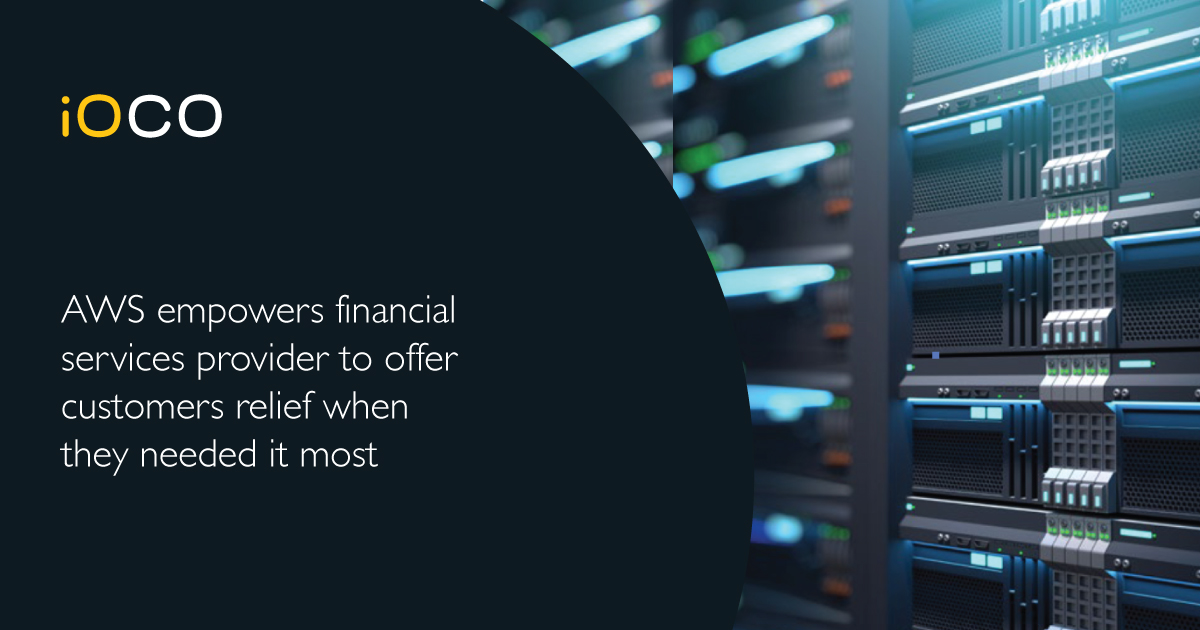When COVID-19 hit, one of our customers, a financial services provider (FSP), wanted to offer payment relief options, to help its own customers through this uncertain time. However, it relied on its holding company’s systems and infrastructure, which typically followed a waterfall development approach.
So, although the FSP wanted to move fast and offer payment relief to customers as soon as possible, deployment would have been delayed by months, at a time when its customers needed financial support the most.
Solution
Management had determined that implementing an Amazon Web Services (AWS) cloud-based solution based on the microservices framework was the way to go.
However, the FSP did not have the in-house experience or skills to design and implement this solution. So, it partnered with iOCO, who brought valuable expertise, knowledge, and experience in next-generation digital infrastructure.
iOCO assisted with:
- Streamlining business processes by adopting an agile design and implementation of AWS cloud-based technologies.
- Driving new business capabilities through the ability to rapidly scale the AWS capacity.
- Empowering the business and its customers by designing and implementing the right cloud-based solution.
iOCO has deep experience providing strategic guidance to companies on their journey to implement a cloud stack that works for them. This includes the development of an agile roadmap to deliver pay-per-use AWS infrastructure and the design, implementation, and deployment of a tailored solution in a multi-cloud environment.
It also created an agile, iterative approach to paint the picture of where WFS wants to be and what steps to follow to achieve this end goal. With each incremental step, a new microservice was added to the AWS technology stack.
DevOps approach
We followed a continuous deployment, continuous integration (CDCI) approach to manage DevOps delivery, using AWS CodeCommit, AWS CodeDeploy, and AWS CodePipeline.
First, we used CodeDeploy to set up Docker containers in Elastic Cloud Storage (ECS) that run on the AWS Fargate serverless compute engine. Once this process was running successfully, additional services, such as monitoring, WAF, and X-Ray, were added with custom-created Lambda functions and interfaces.
The AWS services and technologies used to create these microservices include an application load balancer, WAF (Web Application Firewall), and Docker containers within the Fargate serverless compute engine. Additional services used include an Amazon Aurora database, CloudWatch and X-Ray monitoring services.
Finally, monitoring solutions were implemented to determine when to scale the compute power and data storage capacity up or down, as well as to keep track of the health of the AWS microservices stack.
The DevOps team also used metrics, alerts, and dashboards in AWS CloudWatch to monitor the environment and automatically alert the team to issues that needed human intervention.
Business outcomes
The HTTPS-based front-end and the APIs linking it to the rest of the architecture provide a responsive interface that employees can use to access customer records and action requests.
Benefits include:
- Improved customer management,
- The ability to provide customers with a variety of payment relief measures,
- Reduced monthly premiums through improved customer management processes,
- Reduced financial losses through the effective management of defaulting customers,
- Eliminated system pain points for the business and its customers, and
- Fewer human resources required to monitor the environment 24/7.
Additionally, the technological advantages include:
- The FSP no longer needs to rely on systems that use a waterfall approach, to procure hosting and technology.
- The cloud-based architecture makes it easier for the DevOps team to customise, implement, and monitor AWS microservices.
- DevOps can control their own way of working through the implementation of agile methodologies and cloud-native technology.
- The microservices were decoupled as much as possible to suit the robustness of the architecture.
- The development, deployment, and maintenance of new microservices can be implemented quickly and efficiently.
In today’s fast-paced business environment, organisations can’t afford to wait months to deploy new features and services.
With DevOps now happening automatically, our FSP customer now has a responsive, agile environment and happier customers. while using fewer resources.

